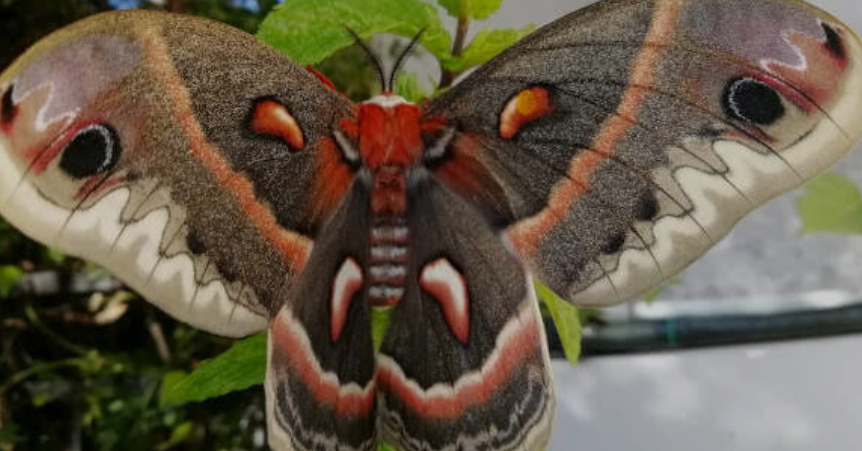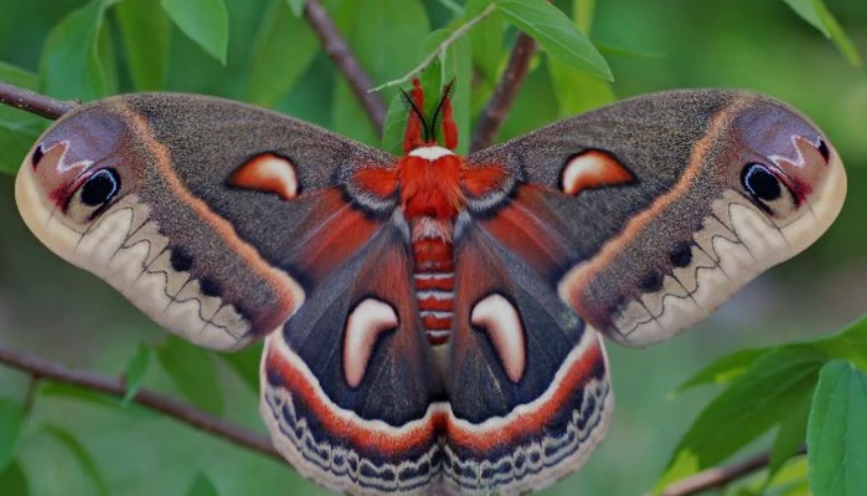
Classification
The Cecropia Moth (Hyalophora cecropia) belongs to the family Saturniidae, commonly referred to as giant silk moths. It is part of the genus Hyalophora within the order Lepidoptera, which includes all moths and butterflies. This species is one of North America’s largest native moths and is closely related to other prominent giant silk moths such as the Luna Moth (Actias luna) and Polyphemus Moth (Antheraea polyphemus).
Identifying Characteristics
Cecropia Moths are renowned for their large size, with a wingspan ranging from 5 to 7 inches (125–180 mm). Their wings are a rich reddish-brown, adorned with white, red, and orange bands and crescent-shaped markings. Large eye spots on the wings help deter predators. The body is thick and furry, usually reddish-brown with creamy bands, giving them a striking and robust appearance. Adults have feathery antennae, particularly prominent in males, which they use to detect female pheromones.
Distribution
The Cecropia Moth is native to North America, predominantly found in the eastern United States and southern Canada. Its range extends from southern Canada through the Great Lakes region and down to the southeastern United States. They are most common in deciduous forests but are also found in suburban areas and parks where host plants are available.
Migration & Habitat
Cecropia Moths are non-migratory, tending to remain in the same local area where their host plants grow. Their preferred habitats include deciduous woodlands, forest edges, suburban gardens, and parks, especially locations with abundant trees and shrubs. They are primarily nocturnal, often resting during the day on tree trunks or branches, and are attracted to artificial lights at night.
Predators & Threats
Predators of Cecropia Moths include birds, bats, small mammals, and predatory insects. The large eye spots on their wings and their nocturnal habits help reduce predation risk. However, they face additional threats from habitat loss, pesticide use, and parasitic wasps and flies, which can attack caterpillars and pupae. Despite these threats, their populations are stable in areas with preserved forests and suburban plantings of host trees.
Lifespan of Adults
Adult Cecropia Moths have a very short lifespan of about 1–2 weeks. They do not feed and rely entirely on fat reserves accumulated during the larval stage. During this time, their sole focus is mating and reproduction. Males are especially active in locating females, using their sensitive antennae to detect pheromones released by females over long distances.
Host Plants & Diet
Caterpillars of the Cecropia Moth feed on the leaves of a wide variety of deciduous trees and shrubs, including maple (Acer spp.), cherry (Prunus spp.), birch (Betula spp.), and willow (Salix spp.). The larvae grow rapidly, passing through multiple instars before pupating. Adult moths, however, do not eat and survive solely on stored energy from the larval stage. The larvae’s feeding contributes to the ecological balance by helping regulate foliage growth in their habitats.
Life cycle of the Cecropia Moth (Hyalophora cecropia)

Egg Stage
The life cycle begins when a female Cecropia Moth lays small, pale green or yellowish eggs on the leaves or stems of host plants. Each female can lay 50–100 eggs, usually in clusters, to ensure the survival of at least some offspring. The eggs hatch in about 10–14 days, depending on temperature and environmental conditions.
Larval (Caterpillar) Stage
Once hatched, the larvae emerge as small, black caterpillars covered with fine bristles. They undergo five to six instars (molts) as they grow, with each stage displaying more vivid colors and patterns, including green bodies with yellow, blue, and red tubercles. These caterpillars feed voraciously on the leaves of their host trees, such as maple, cherry, birch, and willow. The larval stage typically lasts 4–6 weeks, during which the caterpillars accumulate energy reserves necessary for metamorphosis.
Pupal Stage
After reaching full size, the caterpillar spins a cocoon, usually attached to twigs or branches, where it enters the pupal stage. Inside the cocoon, the caterpillar undergoes complete metamorphosis, reorganizing its tissues to form an adult moth. This stage can last several weeks in summer or throughout the winter in colder climates, with the pupa overwintering until conditions are favorable for emergence.
Adult Stage
The adult Cecropia Moth emerges from the cocoon with fully developed wings. Adults are nocturnal and do not feed, surviving solely on the fat reserves accumulated during the larval stage. Their lifespan is short, about 1–2 weeks, during which the primary purpose is mating and reproduction. Males actively search for females by detecting pheromones with their feathery antennae, while females focus on laying eggs to continue the cycle.